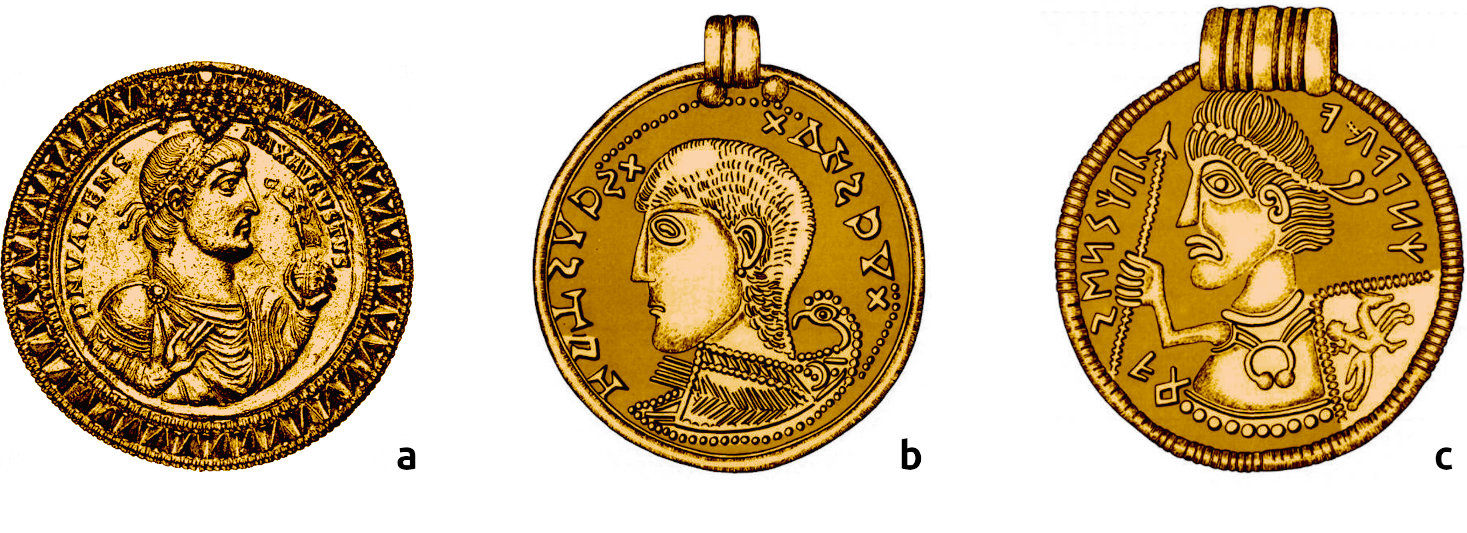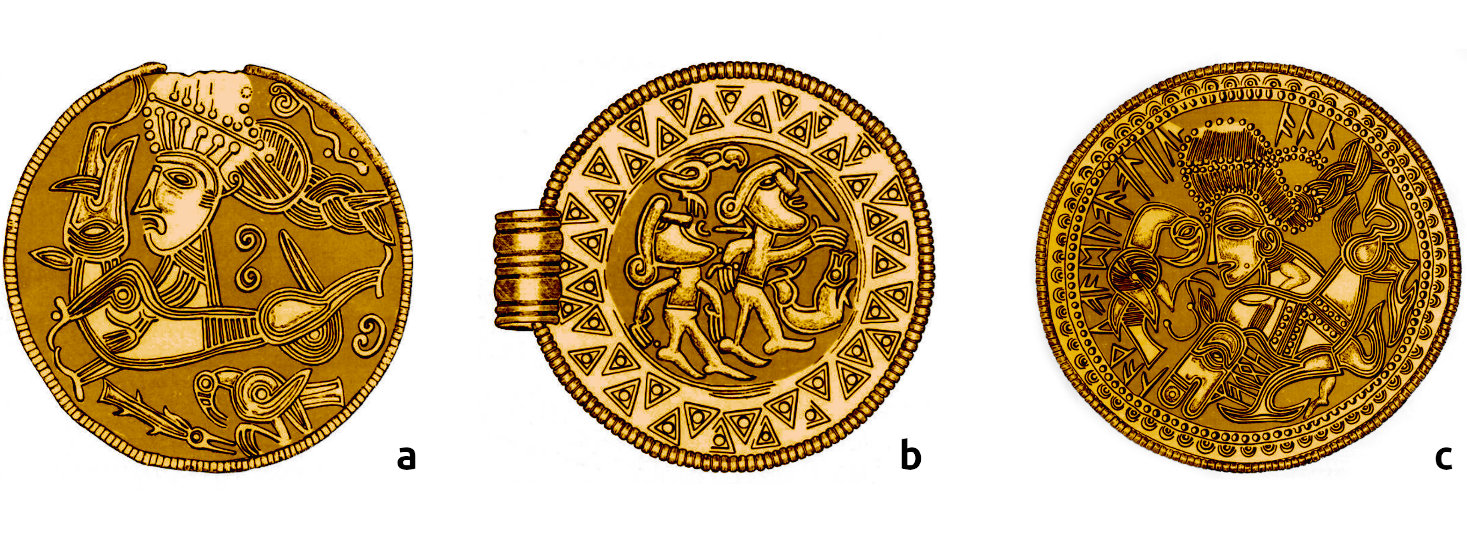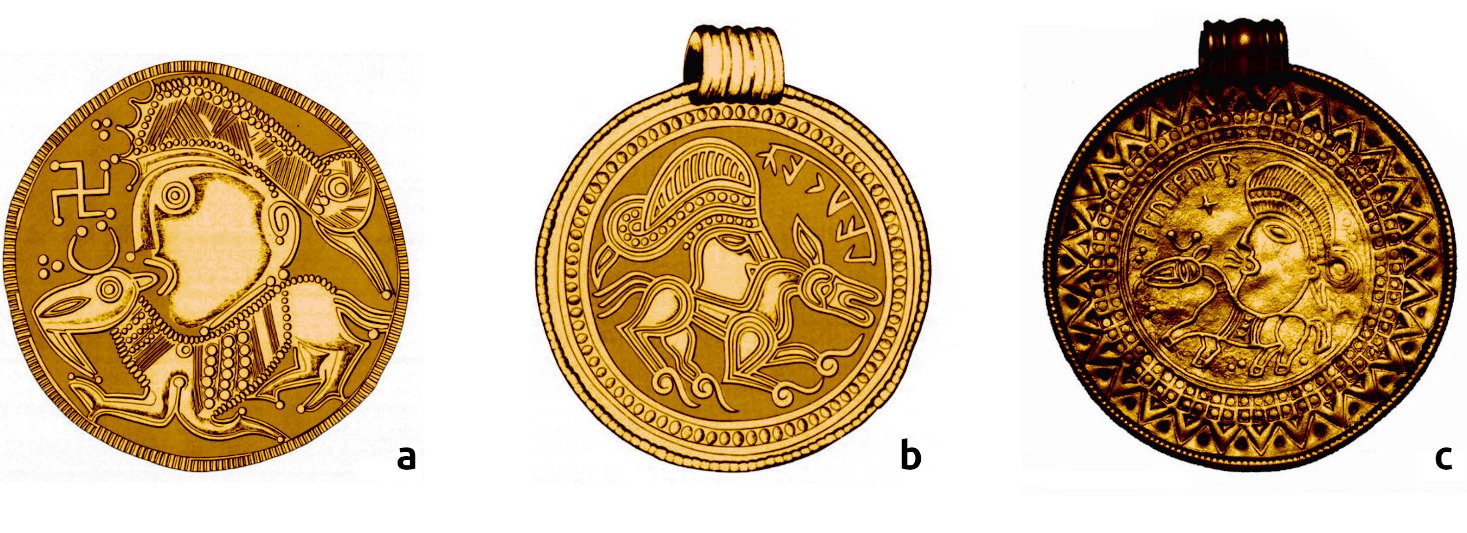The Gold Bracteates of the Migration Period

The Gold Bracteates of the Migration Period are among the most intriguing finds of all Germanic history. Leaving behind the largely non-pictorial Pre-Roman and Roman Iron Age, the number and quality of figural images exploded rapidly with the beginning of the Migration Period thanks in large part to the Gold Bracteates.
This wind of change had a very obvious origin: it came from the South, from the Roman Empire, the largest and longest-lasting superpower in the history of Europe. For centuries it was an enigmatic yet fascinating and inspiring neighbor to the Germanic people. The magnitude of the Roman impact was overwhelming in every aspect reaching even the most remote regions of the Germanic world. In this regard, the Romans took over the role model function that the Celts had previously held for centuries.
The very iconic Tierstil (= Germanic animal style) for example is one of those things directly derived from Roman and oriental templates. Without Roman goods reaching the north there would be no Tierstil and certainly no Gold Bracteates. In fact the Gold Bracteates are a prime example of how heavily the Roman world influenced the Germanic people through their imagery. It all started with Roman medallions (i.e. memorial coins made of gold) reaching the north through gift-giving, trade, looting or even as souvenirs during the 3rd and 4th century CE (see Fig. 1a).
These exotic objects were undoubtedly regarded as something very special and precious. There was simply no one in the north who would have been able to produce such objects with such a detailed imagery. Beyond that however they also must have triggered something in their Germanic observers that inspired their imagination. For it was not the Roman emperors they saw in these images, it was something else.
Death of an Empire – Rise of a New World
With the downfall of the Western Roman Empire during the 5th century the fresh supply of new medallions and coins finally run dry. There was simply no institution or authority left to commission such things. The magnitude of the collapse of Roman culture and society must have been unimaginable. In fact, such a massive meltdown of a civilisation did not came about until a thousand years later when European invaders destroyed the native American world.
The riches of the old Roman Empire became the spoils of the invading Germanic tribes such as the Goths, Franks and the Alemanni. Northern Europe, however, was effectively cut off from the old trading routes and networks. And here’s where things get really interesting, because the demand for such precious products was still consistently high in the north. So naturally the local craftsmen started to imitate those medallions in their very own way (see Fig. 1b).

In the beginning, the motifs still resembled their models, although the workmanship and the level of detail were much less elaborate. Over time, however, new details were added and it becomes obvious that motifs were reinterpreted from a Germanic point of view. Such a detail for instance can be found on the Bracteate IK 299 from Maglemose in Denmark (see Fig. 1c) where the figure is shown wearing a Kolbenarmring (armring with thickend terminals). This armrings were a very common Germanic symbol of power during the late antiquity and later periods.1 One such specimen was found in the grave of Childerich, the last pagan king of the Franks, who died around the time of the Bracteate production. What is extraordinary, however, is that the figure on the Bracteate wears the armring as a pendant around the neck, instead of the wrist, as is usual.
It’s very likely that the people of the north always interpreted the strange motifs on the medallions in their very own way, trying to make sense of it. But with nordic craftsmen now actively recreating and modifying the motifs, we get an idea of what they themselves actually saw in these Roman images.
The Horse and the Sorcerer
The research of the Gold Bracteates was driven in particular by one person: Karl Hauck. Like no other he has shaped the study of Gold Bracteates through decades of intensive work and thereby laid the foundation for today’s comprehensive body of research.
One of the most common Bracteate motifs depicts a horse with an oversized human head on its back. This so called C-Bracteates are found throughout the Germanic world with a clear epicenter in Denmark and Southern Sweden. Thanks to the great variety of this C-Bracteates which are most often accompanied by additional figures, symbols and runes, Karl Hauck developed a method of interpretation for those motifs.
He basically identifies the human head with Wodan healing a wounded horse through his special powers and thereby connecting the motive with the famous Second Merseburg Charm (Wodan healing Balder’s horse). To support his thesis, he refers to numerous details and variations of the motif. A frequent companion for example is a bird right next to the head which Hauck considers to be a symbol for the two ravens of Odin (see Fig. 2c). In fact some Bracteates like IK 133 from Western Sweden actually show two birds simultaneously. According to Hauck it is simply due to the limited space on the Bracteates that there is usually only one bird depicted.2 A further clue to Hauck’s theory can be found in some variants in which the horse is obviously depicted in a tumbling motion. IK 33 for example shows the horse with twisted limbs and the tongue hanging out, while the presumed rider looks rather displeased and shocked, which likewise points to an accident (see Fig. 2a).
Furthermore, there is another single Bracteate, which might depict yet another scene of this plot. Bracteate IK 6 from Års (Northern Jutland) depicts two people moving towards a fallen horse (see Fig. 2b). The right person apparently shows the other one, which is accompanied by a bird, the way to the accident. So, do we actually see Balder here showing Wodan the way to his injured horse?

Linking historical imagery with literary sources is always a highly delicate issue that needs to be dealt with great caution. If we had only the Old Norse sources at our disposal, the time gap between the imagery and the literary records would be enormous. A whole 700 years and thousands of kilometers separate the Gold Bracteates from the extensive Old Norse records of Iceland – too great a distance to make a compelling connection. However, we don’t actually have to bridge such a large gap in time and space. The Merseburg charms were written about 300 years after the production of the Gold Brakteates, but they stem from ancient pagan traditions of the Old Saxon people, which were gradually suppressed by the violent Christianization in the late 700s. C-Bracteates with the horse and the head can be found in many places throughout the Old Saxon lands. One specimen (IK 132) has even been found only 40 kilometers away from Merseburg, where the magic spells were discovered. The chronological and spatial distance to the literary tradition is thus relatively small. But as we all should know, extraordinary claims require extraordinary evidence. So are there any more hints pointing to a connection between the imagery and the horse healing myth? Indeed there are!
Among the most compelling evidence is a small group of Bracteates with runic inscriptions featuring the word hohaR (see Fig. 2c). In contrast to the majority of all runic inscriptions on Bracteates, there is in this case a certain consensus among runologists that the inscription translates to “(the) high one”,3 which is a very common and rather old byname of Wodan-Odin.4 Then there is the large number of magical runic sequences and symbols found on a vast majority of Bracteates. Apart from the very common swastika symbol often found between the horse and the big head (e.g. Fig 3a) it is the runic formulas of alu (ᚨᛚᚢ) and laukaR (ᛚᚨᚢᚲᚨᛉ) which are especially interesting. While it is very difficult to narrow down the exact meaning of the swastika, since it is a very ancient and universal symbol, the interpretation of the alu and laukaR formulas seem to clearly point in the direction of healing magic. Laukar5 as it is for example written on Bracteate IK 8 from Års (Fig. 3b) refers to the wild leek, a plant which has a long history of magical and medical use in Northern and Western Europe.6 The reference to this plant name on Bracteates can therefore hardly be seen in any other way than in the context of a healing or protective function. The same is true for the alu formula, which is the most frequently used runic magic formula of all. Even if the exact etymology of the term is unclear, there is no doubt about the protective function and the apotropaic effect (i.e. to ward off evil) of this magic formula.7
Finally there is the speaking gesture featured on many C-Bracteates. The big head is usually depicted with an open mouth, which is located directly at the horse’s ear (see Fig. 3a). In a variation of the motif on the C-Bracteate IK 600 you can actually see lines coming out of the mouth towards the ear (see Fig. 3c). This clearly suggests that the figure is intentionally speaking or singing to the horse, which corresponds very well with the second Merseburg charm. Thus, when you add up all these pieces, it can be said with reasonable certainty that the C-Bractates are indeed related to the myth of Wodan-Odin healing a wounded horse!

Thanks to the great work of Karl Hauck and others scholars, we have today an extensive illustrated catalogue of the Gold Bracteates, which is available online for free (see links to the catalogue below), as well as several important publications on different aspects of the topic.7 Unfortunately most of this important research work has so far only been published in German, which is somewhat limiting the accessibility to this exciting topic. For this reason and because of the many exciting topics surrounding the Gold Bracteates, I’ll try to release more articles like this one in the future!
Catalogue
K. Hauck (Ed.), Die Goldbrakteaten der Völkerwanderungszeit 1 (München 1985).
- Introduction
- Iconographic Catalogue 1: Text
- Iconographic Catalogue 1: Plates
K. Hauck (Ed.), Die Goldbrakteaten der Völkerwanderungszeit 2 (München 1986).
- Iconographic Catalogue 2: Text
- Iconographic Catalogue 2: Plates
K. Hauck (Ed.), Die Goldbrakteaten der Völkerwanderungszeit 3 (München 1989).
- Iconographic Catalogue 3: Text
- Iconographic Catalogue 3: Plates
Literature
Axboe 2004
Morten Axboe, Die Goldbrakteaten der Völkerwanderungszeit – Herstellungsprobleme und Chronologie (Ergänzungsbände zum Reallexikon der Germanischen Altertumskunde 38). Berlin/New York 2004.Bruder 1974 R. Bruder, Die germanische Frau im Lichte der Runeninschriften und der antiken Historiographie. (Berlin, New York 1974).
Düwel/Nowak 2011
K. Düwel/S. Nowak, Die semantisch lesbaren Runeninschriften auf Goldbrakteaten. In: W. Heizmann/M. Axboe (Hrsg.), Die Goldbrakteaten der Völkerwanderungszeit – Auswertung und Neufunde. RGA Ergbd. 40 (Berlin, New York 2011) 375–474.Hauck 2011
K. Hauck, Die Bildformeln der Goldbrakteaten in ihren Leitvarianten (Zur Ikonologie der Goldbrakteaten, LV). In: W. Heizmann/M. Axboe (Hrsg.), Die Goldbrakteaten der Völkerwanderungszeit – Auswertung und Neufunde. RGA Ergbd. 40 (Berlin, New York 2011) 61–152.Heizmann 1987
W. Heizmann, Bildformel und Formelwort. Zu den laukar-Inschriften auf Goldbrakteaten der Völkerwanderungszeit. In: Runor och runinskrifter. Föredrag vid Riksantikvarieämbetets och Vitterhetsakademiens symposium 8–11 september 1985 (Stockholm 1987) 145‒153.Heizmann/Axboe 2011
Wilhelm Heizmann, Morten Axboe (Hg.), Die Goldbrakteaten der Völkerwanderungszeit – Auswertung und Neufunde (Ergänzungsbände zum RGA 40). Berlin/New York 2011.Müller 2011
G. Müller, Von der Buchstabenmagie zur Namenmagie in den Brakteateninschriften. n: W. Heizmann/M. Axboe (Hrsg.), Die Goldbrakteaten der Völkerwanderungszeit – Auswertung und Neufunde. RGA Ergbd. 40 (Berlin, New York 2011) 317–374.Pesch 2007
Alexandra Pesch, Thema und Variation – Die Goldbrakteaten der Völkerwanderungszeit (Ergänzungsbände zum RGA 36). Berlin/New York 2007.Werner 1980
J. Werner, Der goldene Armring des Frankenkönigs Childerich und die germanischen Handgelenkringe der jüngeren Kaiserzeit. Frühmittelalterl. Stud. 14, 1980, 1–49.
- Cf. Werner 1980. ^
- Cf. Hauck 2011, 68–70. ^
- Cf. Müller (2011, 321) and Düwel/Nowak (2011, 471–473). ^
- The Hávamál (“sayings of the high one”) for example is believed to be among the oldest of the Eddic poems dating back at least to the 10th century, but probably even further back in time. ^
- In modern Icelandic it is still called laukar today. ^
- Cf. Heizmann 1987. ^
- Bruder 1974, 22–26. ^